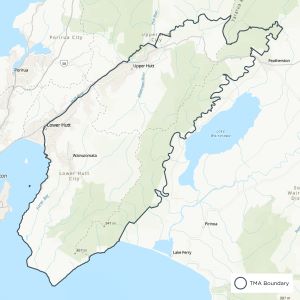Remutaka-Hutt TB Management Area (TMA)
Pest control work planned for Remutaka-Hutt includes ground control, aerial control and wildlife surveillance.
Eradicating bovine TB in NZ
As part of our TBfree programme we deliver our pest control operations through a framework of TB management areas (TMAs). TMAs are areas with known TB infection in livestock or wildlife. Each TMA has a specific TB control plan designed to eradicate TB as effectively as possible.
 The Remutaka-Hutt TMA
The Remutaka-Hutt TMA
The Remutaka-Hutt TMA runs from Kaitoke in the north, to Pencarrow Head, Baring Head and Turakirae Head in the south. Most of the western boundary is the Hutt River. In the east, much of the boundary is the eastern boundary of the Remutaka Forest Park.
On the eastern side of the TMA are the bush-covered hills and mountains of the Remutaka Range. The urban populations of Hutt City and Upper Hutt City are in the west of the TMA, on the edges of the shrub and gorse-covered Eastern Hutt hills. Mangaroa Valley, Whitemans Valley and Moores Valley are all included in the TMA.
History of TB and pest control in Remutaka-Hutt
The Remutaka-Hutt TMA has a long history of TB infection in cattle herds and local wildlife, starting in the 1980s. We've found infected wildlife in, or very close to, all parts of the TMA.
Since 1996, we've caught:
- 31 infected possums
- 9 infected pigs.
Previous possum control and livestock disease management has reduced the number of infected herds in the Wellington region. However, our monitoring has shown that we need to do further control work in the Remutaka-Hutt area to reduce the possum population. This will:
- minimise the risk of the disease spreading through wild animal populations into farmed cattle and deer
- ensure further good progress towards eradicating TB.
We completed aerial control in:
- Mangaroa Kaitoke in 2019
- Orongorongo in 2018 and 2022
- Featherston Crown, Featherston to Waiorongomai Crown, and Mangaroa Kaitoke in 2025.
We completed ground control in:
- Mangaroa Kaitoke and Wainuiomata South in 2019/2020 and 2021/2022
- Orongorongo in 2021/2022.
Some areas, such as Hutt Valley and Moores Valley, have had very little control in recent years.
Current state
As of June 2025, there are no infected herds in the Remutaka-Hutt TMA.
If you're moving animals
The Remutaka-Hutt TMA is in the Wellington Movement Control Area. Before you move cattle or deer to another herd or farm, you must have them tested for bovine TB.
Future pest control operations
We plan our pest control operations up to 3 years in advance. The current year runs from July 2025 to June 2026.
Dates and control methods for pest control operations in Remutaka-Hutt are provisional and subject to change. If you’re affected by any upcoming operations, our pest control contractors will contact you before work begins. They will:
- talk you through the specifics of each operation
- explain what you need to do before the operations start
- get your consent for the work to be done.
| Type of control | When | Coverage | Where |
|---|---|---|---|
| Ground control | 2025/2026 | 10,598ha | Mangaroa Kaitoke |
| Aerial control | 2025/2026 | 2249ha | Mangaroa Kaitoke |
| Pig survey | 2025/2026 | 5674ha | Remutaka-Hutt |
Map of 2025/2026 pest control operations
On the map, the proposed area for:
- ground control is marked in green
- aerial control is marked in yellow
- wildlife surveillance is marked in blue.
Interactive map showing Remutaka-Hutt TB management area boundaries, Vector Control Zone, and proposed control areas.
Contacts
Supplejack Contracting Limited manages eradication activities in the Remutaka-Hutt TMA. Contact them directly if you have feedback or questions about upcoming operations.
Supplejack Contracting Limited
Phone: 06 378 8414
Email: admin@supplejackcontracting.co.nz
OSPRI
PO Box 3412
Wellington 6140
Phone: 06 353 2710
Email: vector.sni@ospri.co.nz

